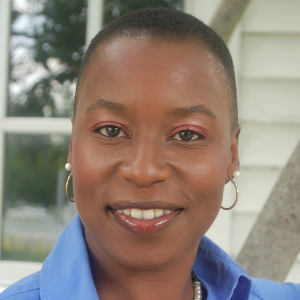That’s because Parks wasn’t there simply to play lookout. She was the lookout.
“She wanted to see him shoot a Ku Kluxer,” Parks biographer Jeanne Theoharis says of the civil rights icon’s motivation for those evenings spent serving as a sentry for her grandfather.
Even at such a young age, Parks’ reserved personality belied her rebellious side churning within.
For Theoharis, a distinguished professor of political science at Brooklyn College of the City University of New York and author of the award-winning book “The Rebellious Life of Mrs. Rosa Parks,” that moment and a constellation of others throughout her childhood marked a pivotal point in her upbringing.
“I think we have to see sort of rebellious roots in some sense, both beginning at home and partly as a kind of personal characteristic of her,” Theoharis tells News Beat podcast.
For African Americans, Alabama at the time was a tinderbox. Between 1877 and 1950, there were more than 300 lynchings in the heart of the disgraced confederacy. Pine Level, the neighborhood where Parks was raised, had seen an uptick in Klan terror during her years there, according to Theoharis.
If anyone needed more evidence of Parks’ “rebellious side,” as Theoharis calls it, look no further than the time a white boy pushed her in the street, prompting her to retaliate in kind. The boy’s mom, according to Theoharis, threatened to have her arrested.
Parks’ grandmother was aghast when she heard news of the confrontation, fearful that the young girl’s behavior could lead her to a tragic fate all too common among the oppressed and disenfranchised community.
“I’d rather be lynched then not be able to say ‘I don’t like it,’” Theoharis recalls Parks telling the family matriarch.
Every American icon experiences indelible moments that propel them into the cultural lexicon. Parks was no exception. The “Mother of the Movement” stormed into the national consciousness on Dec. 1, 1955, when she was arrested for refusing to give up her bus seat to a white man when ordered, sparking the Montgomery Bus Boycott. The protest had persisted for 11 months when the U.S. Supreme Court in November 1956 upheld a lower court ruling striking down the city law that permitted racial segregation on its bus lines.
“Rosa parks will spend the second half of her life, even longer than she spends in Montgomery, fighting the racism of the ‘Jim Crow North.'”
– Jeanne Theoharis, Professor at Brooklyn College at the City University of New York.
Life of Activism
Parks would’ve been 18 years old in 1931 when nine black boys were arrested on a freight train in Alabama and falsely accused of raping two white women.
The plight of the “Scottsboro Boys,” as they became known, underscored how precarious life was for young black teenagers and men in the South. The nine boys ranged in ages of 13 to 20, and all but one were sentenced to death. The U.S. Supreme Court later intervened and overturned their convictions.
It was the same year Parks met her future husband Raymond, who had been working on the Scottsboro case. They married a year later.
“What really changes it is when she meets and falls in love with, as she describes it, the first real activist she ever met,” says Theoharis, referring to Raymond.
“In the first years, he’s the more public activist. She’s working more behind the scenes,” adds Theoharis. “She remembers late-night meetings at their house, guns across the table. It’s even dangerous to have a meeting around this. But by the 1940s, she’s wanting to play an even more active role. She’s galled by the fact that black people are serving overseas during the war. This is World War II. Her brother’s serving overseas, and yet black people are largely not able to vote at home.”
In these early years, Parks was setting the stage for a life of constant rebellion. In 1943, she attended her first ever meeting at her local National Association for the Advancement of Colored People (NAACP) branch, and was elected branch secretary that very same day. It was around this time that Parks felt the pull to register to vote, despite the many barriers preventing blacks from joining the electorate.
“I had been pushed around all my life and felt at this moment that I couldn’t take it anymore.”
– Rosa Parks
As Parks slowly made the progression toward pioneering activist, she was forging relationships with other prominent civil rights advocates, the union organizer E.D. Nixon, among them.
When an undaunted Parks expressed interesting in registering to vote, Nixon stopped by her house to drop off election materials. The occasion sparked a partnership that would forever “change the face of American history,” says Theoharis, “because E.D. Nixon and Rosa Parks will set about to, in some ways, transform Montgomery’s NAACP into a more active and activist branch.”
Among the causes Parks and Nixon took on was the arrest of 16-year-old Jeremiah Reeves, who was accused of raping a white woman and eventually executed. Parks and the Montgomery NAACP fought tirelessly, but to no avail.
Reeves’ execution was particularly devastating.
“It was very difficult to keep going when all our work seemed to be in vain,” Parks reportedly said.
Theoharis says the mounting defeats took a toll on Parks, but she found solace in a two-week training course at The Highlander Folk School in Tennessee, which helped train civil rights activists in the South. Parks described the experience as “transformative,” according to Theoharis, and returned to Alabama eager to help build the burgeoning ranks of young activists, also founding the youth branch of the NAACP.
Her stint at Highlander came only four months before she’d make her famous stand on Dec. 1, 1955.
“I had been pushed around all my life and felt at this moment that I couldn’t take it anymore,” Parks later famously wrote.
‘The Northern Promised Land That Wasn’t’
By the time the boycott had ended, the Parks were suffering from financial hardships. Both Rosa and Raymond had lost their jobs, and the constant drumbeat of death threats became an inescapable part of life.
Montgomery, which Parks one referred to as the “Cradle of the Confederacy,” would lose its most famous Freedom Fighter.
But Parks did not lose the spirit and determination that fueled her quarter-century pursuit of a more just society.
“It’s really a theme of her life that she was one who would not back down from unfairness or maltreatment of her or her people,” Yolanda Jack, Youth Programs coordinator at the Charles H. Wright Museum of African American History in Detroit, tells News Beat podcast.
While Parks was intent on continuing her activism in the Motor City, the liberal class, including many journalists, seemed disinterested in the plight of African Americans in the North.
As Theoharis writes: “The Southern focus of Mrs. Parks’ interviewers reflected a broader blindspot among liberal commentators and subsequent historians to the parallels between Southern and Northern racism and anti-racism struggles. By the early 1960s, the national media (based outside of the South) had grown increasingly sympathetic to the nonviolent Southern struggle. Conversely, while Northern protests often made front-page news, they were not framed through the same righteous lens used for the Southern movement.”
“Even when interviewers in the 1960s and 1970s asked her questions on contemporary race relations,” Theoharis continued, “they often inquired about the current racial situation in the South. Parks was almost never asked about whether things in Detroit had changed, about the Kerner Commission Report, Northern school segregation, Nixon’s welfare policies, police brutality, or the war in Vietnam—despite her considerable attention to these matters.”
The Kerner Committee Report, which became a best-seller and was named after Otto Kerner, the chairman of the committee selected by President Lyndon B. Johnson after race rebellions broke out across the country, was blunt in its assessment of racist housing practices and other societal ills that effectively treated blacks as second-class citizens.
To learn more about the Kerner Report, listen to our podcast, “Kerner Report 50 Years Later: America Is Even More ‘Separate & Unequal’”
Detroit, where the black population grew by 611 percent during the Great Migration, became the scene of intense race riots in 1967.
To commemorate the 50th anniversary of the Kerner Report, Reynolds Farley, professor emeritus at the University of Michigan’s Population Studies Center, wrote: “African Americans were targeted for abuse by the police, denied opportunities for education, and unable to compete fairly in the labor market because of discrimination. Underlying these racial inequities was the denial of opportunities in the housing market.”
How northern elites persistently failed to scrutinize and prosecute segregation above the Mason-Dixon Line wasn’t lost on Parks. She was among thousands of black southerners to make a new life in Detroit during the Great Migration, which lasted parts of seven decades.
“I don’t know whether I could have been more effective as a worker for freedom in the South than I am here in Detroit,” Parks said, according to Theoharis. “Really, the same thing that has occurred in the South is existing here to a certain degree. We do have the same problems.”
Northern ignorance what it was, Parks persevered. She joined Conyers’ office in 1965 and was a recognizable face among blacks in Detroit. She also focused her energy on opposing the Vietnam War and organizing around the so-called “People’s Tribunal” trying to hold police accountable for the killing of unarmed black men in the city.
“She was very connected to activities and the frustrations of the community,” says Jack. “As a person who grew up in the city of Detroit with her living here, we felt a great deal of respect…she was just a great example of how to live your life connected to the people in their work and in working [on] behalf and in service of them.”
Racial inequality was so encroaching that civil rights leaders in the city decided they had enough. In 1963, they organized what was then considered the largest mass demonstration in U.S. history, dubbed “The Great March to Freedom,” which rivaled the size of the March on Washington, which occurred two months later.
The march, writes Theoharis, “highlighted the severe inequalities in Detroit and helped to accelerate a rising black militancy in the city.”
The main attraction was the civil rights leader Rev. Dr. Martin Luther King, Jr. himself, who sharply shredded the myth that segregation was non-existent in the North.
“Now the second thing that you can do to help us down in Alabama and Mississippi and all over the South is to work with determination to get rid of any segregation and discrimination in Detroit, realizing that injustice anywhere is a threat to justice everywhere,” King said. “And we’ve got to come to see that the problem of racial injustice is a national problem. No community in this country can boast of clean hands in the area of brotherhood. Now in the North, it’s different, in that it doesn’t have the legal sanction that it has in the South. But it has its subtle and hidden forms and it exists in three areas: in the area of employment discrimination, in the area of housing discrimination, and in the area of de facto segregation in the public schools. And we must come to see that de facto segregation in the North is just as injurious as the actual segregation in the South.”
Parks, of course, was at the rally, walking alongside King at the front of the march, according to Theoharis.
Parks was seemingly always present when the moment beckoned, and that’s an essential fact to recognize when attempting to understand her full legacy.








